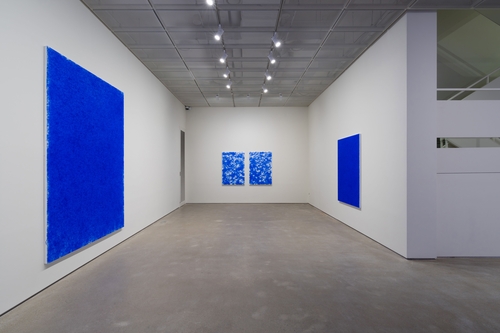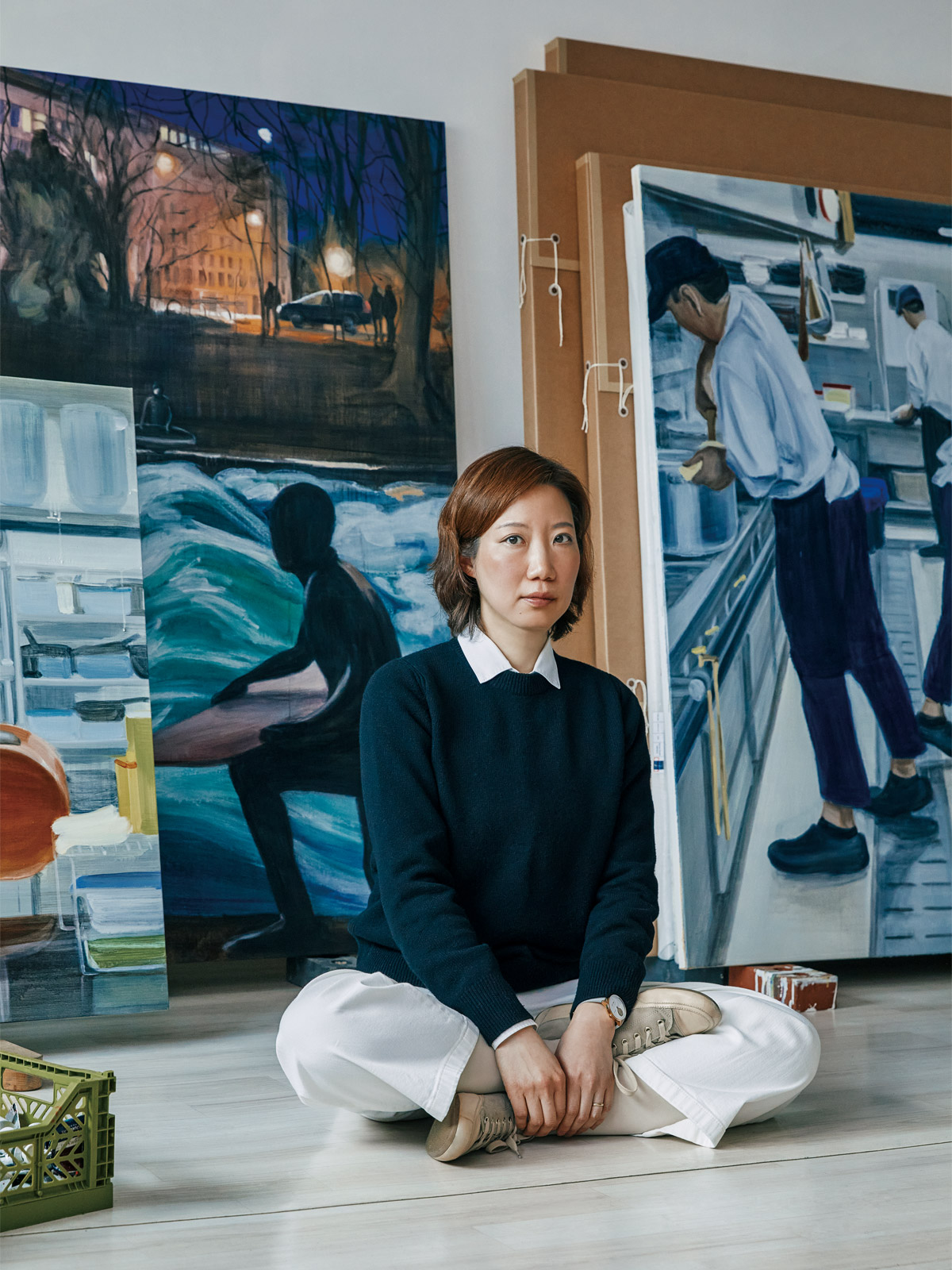Kim Tschoon-su (b. 1957), a leading figure in the ‘Post-Dansaekhwa’ group and the artist of ‘Ultra Marine’, has attracted attention for his unique finger painting technique, in which he wears thin gloves instead of brushes, and uses paint on his palms and fingers to ‘touch’ the canvas to build up thin layers of color.
For nearly 30 years, since the early 90s, Kim has been painting ultramarine blue, noting that “blue” is not just one color, but a deep blue that contains the light of nature. In order to get closer to the essence of the painting, Kim explores the depth of the paint and the plane and works to penetrate into it.

Kim Tschoon-su, 8012 CIRCLE 8012, 1980. ©Kim Tschoon-su
In the early 80s, Kim Tschoon-su developed the series ‘Photographic Work’. At this time, he captured objects on camera to convey an independent meaning and message that the artist’s point of view and behavior also become a medium of expression. His photographic work focuses on the ‘view’ of the object while it is represented as a statue, rather than the viewer looking at the figure represented on the film. Through this, Kim established the concept of ‘incarnation,’ which led him to discover the meaning of ‘the nature of space’ and ‘relationship with objects.’

Kim Tschoon-su, 8012 CIRCLE 8012, 1980. ©Kim Tschoon-su
In the mid-80s, he introduced the Window series, which centers on the theme of ‘in-between’ between the inside and outside. The series consists of drawing lines that look like windows or window frames on paper and cotton cloth, and then erasing the screen with acrylic paint and ink. The artist considers the ‘window’ as a structure where the mind (inside) and the world (outside) meet, and intends to integrate the structural situations of the two into one through the ‘method of erasing’ the structural difference between the real and visible world.

Kim Tschoon-su, Strange Tongue 9535, 1995. ©PYO GALLERY
One of Kim’s signature works from the early 1990s, the Strange Tongue series depicts what exists beyond the limits of language that cannot be fully expressed in words into the painting. The series is based on the idea that when words or visual images are used to describe something, they become the most distant from reality and essence due to the intervention of intention and purpose.
In order to eliminate the distance from reality (essence) created by this intervention of narrative intention, Kim sought to reflect the unconscious and unintentional breathing of the artist. To this end, the artist repeated the act of drawing with paint on the front of the screen by dipping his hand into the paint, giving form and rhythm to the process of countless overlaps and erasures of lines

Kim Tschoon-su, SWEET SLIPS 9932&9933, 1999. ©Rho Gallery
In the subsequent series of Untitled, SWEET SLIPS, and blanco y azul, the artist immersed himself in drawing through the movement of his body in order to find answers to questions about the meaning of ‘drawing’. After realizing that painting with a brush always resulted in a similar range and distanced him from the essence of the painting he was trying to approach, Kim experimented with methods such as dipping paper or tissue in paint and applying it to the canvas, or using his fingers instead of a brush by wearing several layers of thin plastic gloves.
Through repetition of the act of applying paint directly on the body and covering it again, rather than using a brush, the artist actually stopped painting something. By matching the body and paint, the paint settles on the canvas as a concrete entity.

Kim Tschoon-su, ULTRA-MARINE 1901, 2019. ©Gallery Shilla
The Ultra-Marine series, which he has been presenting since 2002, is an extension of his previous works, which ask the fundamental question of ‘what is painting’. Ultra-Marine is not only the name of the paint color, but also a combination of the words ‘marine’, meaning sea, and ‘ultra’, meaning transcendence. The artist wanted to get closer to the ‘essence of painting’ by going beyond the surface of this colored painting, which at first glance looks like a blue sea, into the deep sense of space of the painting like a deep layer of paint.
He conceptually borrows the witty and speculative elements of multiple meanings of language, questions contemporary art, and has been constantly experimenting and trying to find answers to his own artistry through painting. Kim Tschoon-su seeks to overcome the limits of consciousness through an act of repetition, a thoughtful experiment based on the essence of painting itself.
“I want to believe that there is something beyond the limits of language, that what cannot be put into words must be kept in silence. And the paradox, the will to express it in any form, is another name for the spirit of art.”

Artist Kim Tschoon-su ©PYO GALLERY
Kim Tschoon-su graduated from the Department of Painting at Seoul National University and Graduate School at the same university, and received his MFA from California State University, San Francisco and PhD from New York University. In 1993, he was awarded the 3rd Total Art Grand Prize. In 1996, he was selected to represent Korean Pavilion at the 23rd Bienal de São Paulo, and in 2003, he was a visiting scholar at the University of Alcalá, Spain. From 1996 to 2022, he was a professor at the Seoul National University College of Fine Arts.
He has held solo exhibitions at Johyun Gallery, Sun Gallery, Gallery Lee&Bae, Galerie Son (Berlin), The Page Gallery, and Seoul National University Museum of Art, and participated in group exhibitions at the National Museum of Modern and Contemporary Art, Korea (Gwacheon) and Museum SAN. His works are in the collections of LA Artcore Center, Art Sonje Center, Hansol Cultural Foundation, Total Museum of Contemporary Art, Sungkok Art Museum, National Museum of Modern and Contemporary Art Korea (MMCA), Seoul Museum of Art, POSCO Center, Daejeon Museum of Art, and the Embassy of Korea in Berlin.



















